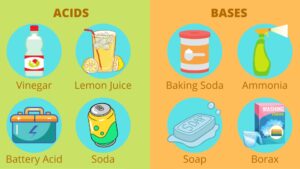An Introduction to Acids and Bases
Acids are substances with a pH below 7 that release hydrogen ions or a proton when combined in an aqueous solution. The dissociable protons or hydrogen groups, also known as acidic hydrogen, that easily split apart in solution or the presence of bases are the main constituent of these acids.
Bases are substances that yield hydroxyl ions when combined with water in an aqueous solution when combined with water in an aqueous solution, yield hydroxyl ions. Their pH is higher than 7. Therefore, a base has a basic group that separates in an aqueous media or a dissociable hydroxyl group. Bases may also be referred to as substances that are hydrogen acceptors because they are substances that can either receive or accept hydrogen ions.
The pH Scale
The pH scale determines the strength of an acid or base by specifying the degree of dissociation. A strong acid or base dissociates in water, producing massive amounts of hydrogen or hydroxyl ions. A dissociation constant is used to calculate an acid or base’s dissociation of an acid or base.
Strong Acid
Since extremely acidic hydrogens are extremely acidic hydrogens present, strong acids HA has a high dissociation. Commonly, these hydrogens are attached to extremely electronegative groups (often halogens like chlorine, fluorine, and iodine).
Low pH is found in strong acids. The amount of hydrogen ions in a solution is related to the pH. The negative logarithm of the concentration of hydrogen ions is the mathematical representation of pH.
\[pH = – \log [{H^ + }]\]
The dissociation constant of acids, a parameter \({K_a}\), is used to account for the degree of dissociation. Increased dissociation and hence higher acidity are indicated by a high \({K_a}\) value.
In chemistry, the \(p{K_a}\) value—the negative logarithm of \({K_a}\)—which is the logarithmic acid dissociation constant—is taken into account for convenience. Therefore, stronger acids will have a low pKa value and a high acid dissociation constant \({K_a}\) value, and vice versa.
\[p{K_a} = – \log {K_a}\]
Examples of Strong Acids
| Strong Acids | Formula |
| Hydrochloric Acid | HCl |
| Sulphuric Acid | H2SO4 |
| Nitric Acid | HNO3 |
Strong Base
Strong bases NaOH are substances that split apart in solution to form high quantities of hydroxyl ions. In addition, bases have the potential to be strong proton acceptors, which means that they could grab a proton from the water molecule \({H_2}O\) in an aqueous solution to produce an \(O{H^ – }\) ion.
\[NaOH \to N{a^ + }(aq) + O{H^ – }(aq)\]
The base dissociation constant Kb describes the level of dissociation in the case of bases. Stronger bases are associated with lower values of the logarithmic base dissociation constant, or, which is equivalent to \(p{K_a}\).
\[p{K_b} = – \log {K_b}\]
Similar to pH, the concentration of hydroxyl ions is related to pOH. A strong base that supplied a lot of hydroxyl ions would have low pOH because the concentration of hydroxyl ions is a negative logarithm.
\[pOH = – \log [O{H^ – }]\]
The equation pH + pOH = 14 relates pH and pOH in an aqueous solution. If one is known, the other can be used to compute either pH or pOH.
Strong bases commonly have a pH range of 13–14.
Examples of Strong Bases
| Strong Bases | Formula |
| Calcium Hydroxide | Ca(OH)2 |
| Sodium Hydroxide | NaOH |
| Potassium Hydroxide | KOH |
| Lithium Hydroxide | LiOH |

Summary
Strong acids and bases are the subjects of this article, which also examines how strong acids or basic solutions are based on their pH. Strong acids and strong bases have a high degree of dissociation. Strong acids and bases dissociate in solution, releasing a lot of proton and hydroxyl ions. Strong bases have high pH, whereas strong acids have low pH.
Frequently Asked Questions
1. What is the Body’s pH?
Ans. The pH of human blood ranges from 7.35 to 7.45, making it very slightly alkaline. With a pH range of 1.5 to 3.5, the human stomach is the most acidic organ in the body. To break down food for digestion and remove any unwanted microorganisms, the stomach is kept at a low pH.
2. What are the Main Differences between a Strong Acid and a Weak Acid?
| Strong Acids | Weak Acids |
| When exposed to water, strong acids completely dissociate into their ions. | In an aqueous solution, weak acids are molecules that partially dissociate into ions. |
| A strong acid solution has a very low pH. | A weak acid solution has a pH of 3-5. |
| It releases all the H+ ions to the solution. | Partially releases all H+ ions to enter the solution. |
3. What are the Main Differences between a Strong Base and a Weak Base?
| Strong Bases | Weak Bases |
| In a solution, a strong base can completely dissociate into its cation and hydroxyl ion. | A weak base partially dissociates into its hydroxyl ion and cation, resulting in an equilibrium state. |
